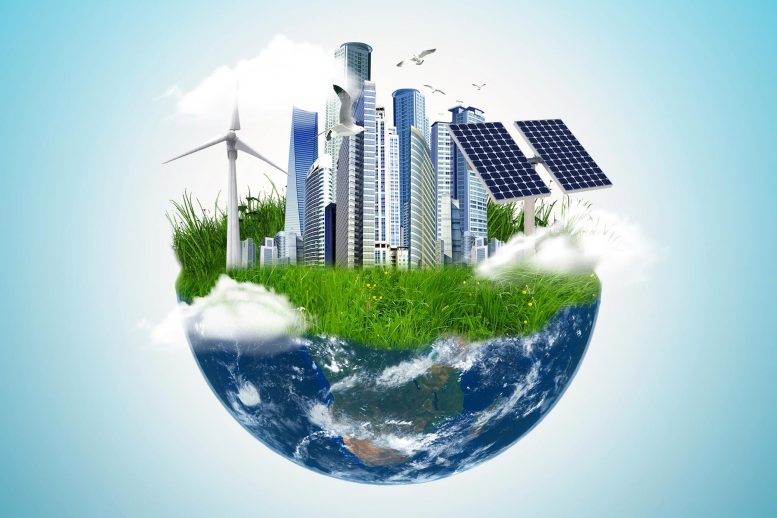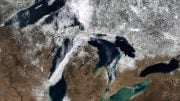
A study assesses the economic impact of imposing a carbon takeback obligation on the fossil fuel industry, showing it as an affordable and low-risk path to achieving net-zero emissions, particularly when paired with conventional measures to reduce near-term fossil fuel demand.
Stop fossil fuels from causing global warming within a generation… The Carbon Takeback Obligation could do just that.
Imagine a single policy, imposed on one industry, which would, if enforced consistently, stop fossil fuels from causing global warming within a generation. The Carbon Takeback Obligation could do just that. It requires fossil fuel extractors and importers to dispose safely and permanently of a rising fraction of the CO2 they generate, with that fraction rising to 100% by the year of net-zero. Critically, this would include carbon dioxide generated by the products they sell.
A ground-breaking study by the Universities of Oxford and Edinburgh, published today (October 26, 2021) in the international energy journal Joule, explores the economic implications of imposing a carbon takeback obligation on the global fossil fuel industry, and shows it provides an affordable and low-risk route to net zero emissions, particularly if complemented by conventional measures to reduce near-term fossil fuel demand.
Oxford researcher Stuart Jenkins, lead author of the study, explains, “Despite the perceived high cost of carbon dioxide capture and storage, we show that the cost to the world economy of a Carbon Takeback Obligation, even if entirely passed on to fossil fuel consumers, is no higher than the cost of mitigation in conventional scenarios meeting similar goals driven by a global carbon price.”
Professor Stuart Haszeldine of the University of Edinburgh, a report co-author, says, “Investment in carbon dioxide capture and geological storage has, to date, been dependent on state subsidies, and consistently far below what is required to meet Paris climate goals. Carbon Takeback provides the fossil fuel industry itself with the strongest possible incentive to make amends: survival.”
Oxford’s Professor Myles Allen, another co-author adds, “Carbon Takeback has consistently been dismissed by the climate policy establishment as much more expensive and risky than the alternative of driving down consumption by changing consumer behavior or through a global carbon price. But these options are hardly risk-free. Getting to net-zero means carbon prices rising to $1000 per tonne of CO2 by 2050: 100 times the hike that brought out the gilets jaunes [yellow vests].”
Margriet Kuijper, an independent expert in carbon capture and storage who reviewed the work, comments, “A Carbon Takeback policy as proposed in this paper will provide a safety net to make sure we achieve net zero emissions even if we don’t manage to reduce the use of fossil fuels quickly enough. It extends the responsibility of producers to take care of the waste generated by the use of their products. The polluter pays to clean up. And the costs are included in the product price. As it should be.”
Reference: “Upstream decarbonisation through a Carbon Takeback Obligation: an affordable backstop climate policy” by Stuart Jenkins, Eli Mitchell-Larson, Matthew C. Ives, Stuart Haszeldine and Myles Allen, 26 October 2021, Joule.
DOI: 10.1016/j.joule.2021.10.012
True Planet: Oxford research for a changing world
The world around us is changing, and Oxford researchers are at the forefront of trying to understand better the reasons for global temperature and sea level increases, extreme weather events, plastic waste proliferation, and threats to biodiversity.
Our researchers are working with partners in industry, government, the third sector, and at other universities to address these challenges and to propose innovative approaches and solutions.
The University of Oxford
Oxford University has been placed number one in the Times Higher Education World University Rankings for the fifth year running, and at the heart of this success is our ground-breaking research and innovation. Oxford is world-famous for research excellence and home to some of the most talented people from across the globe. Our work helps the lives of millions, solving real-world problems through a huge network of partnerships and collaborations. The breadth and interdisciplinary nature of our research sparks imaginative and inventive insights and solutions









This proposal is based on the unproven assumption that humans are totally responsible for the rise in global temperatures. While it is a popular paradigm, it is largely based on imperfect computer models. The models are known to run warm, in part because they are based on a retro-reflection albedo, instead of total reflectivity. That is, the models ignore the forward reflecting specular reflection of water and bare ice. Thus, the albedo is a lower-bound on the total reflectivity.
The models implicitly assume that whatever forcing(s) caused the end of the Little Ice Age, it/they stopped working at the beginning of the Industrial Revolution.
Furthermore, while the models are defended as being based on “science,” the reality is that modern computers aren’t up to the task of rigorously handling the energy exchanges involving clouds. As a consequence, the role of clouds is ‘parameterized,’ which is a fancy way of saying that assumptions are made about all the processes involved, and they are simplified to produce an average ‘fudge factor.’ Clouds play a critical role in determining Earth’s albedo!
The public is routinely scared with claims that a particular year or month is the warmest ever, or in the last 10-years. This is typically based on a claim of a difference of 0.01 deg C, when the raw data are recorded to about the nearest 0.5 +/- 0.05 degs C. I’m of the opinion that the rules for propagation of uncertainty in calculations are not followed rigorously.
We are being stampeded into accepting energy that is much more expensive and less reliable!
Regarding the claim that human causes of global warming are “unproven”.
“There is no “proof” in science — that is a property of mathematics. In science, what matters is the balance of evidence, and theories that can explain that evidence. Where possible, scientists make predictions and design experiments to confirm, modify, or contradict their theories, and must modify these theories as new information comes in.
In the case of anthropogenic global warming, there is a theory (first conceived over 100 years ago) based on well-established laws of physics. It is consistent with mountains of observation and data, both contemporary and historical. It is supported by sophisticated, refined global climate models that can successfully reproduce the climate’s behavior over the last century.
https://grist.org/climate-energy/there-is-no-proof-that-co2-is-causing-global-warming/
You are correct that one cannot prove a hypothesis. Although, colloquially, it is common to say that supporting evidence ‘proves’ a claim. At best, one proposes multiple working hypotheses. Those that are impossible, or for which there is no supporting evidence, are rejected. What remains is framed in a manner that it can be falsified, or alternatively, a formal null hypothesis is proposed. If the null hypothesis cannot be falsified, then one may be uncertain which, if either, is correct. If the null hypothesis can be falsified, then it is assumed that the hypothesis is correct, subject to further attempts to show it to be wrong.
One of the most important reasons for formulating a hypothesis is to use it to explain or predict complex processes. However, if the predictions are wrong, then the hypothesis is clearly wrong and needs to be replaced. It is often said that mathematics is the language of science. Therefore, it isn’t just a general trend or tendency that supports a hypothesis, but it is the value and uncertainty associated that is important in demonstrating that it has utility as a predictor and is probably correct.
Yes, Arrhenius and others discovered that CO2 absorbs IR radiation. However, with respect to the anthropogenic influence on global temperatures, what is important is whether or not the ‘numbers’ are right.
The 30th anniversary of James Hansen’s infamous 1988 predictions was celebrated recently. The media congratulated him on how well his predictions performed. I did an analysis of his prediction laid out here:
https://wattsupwiththat.com/2018/06/30/analysis-of-james-hansens-1988-prediction-of-global-temperatures-for-the-last-30-years/
I don’t expect you to read it, so I’ll give you the quick summary. A simple linear extrapolation of his own data did a better job of predicting the last 30 years than his model did. His best scenario only managed to get close to reality by him assuming two significant volcanic eruptions, which didn’t take place.
Your claim that the computer models are inaccurate is incorrect…they are quite accurate and have actually been found to have been overly conservative, based on 30 years of data collection. “A 2019 study led by Zeke Hausfather evaluated 17 global surface temperature projections from climate models in studies published between 1970 and 2007. The authors found “14 out of the 17 model projections indistinguishable from what actually occurred.”
“Climate models have to be tested to find out if they work. We can’t wait for 30 years to see if a model is any good or not; models are tested against the past, against what we know happened. If a model can correctly predict trends from a starting point somewhere in the past, we could expect it to predict with reasonable certainty what might happen in the future.
So all models are first tested in a process called Hindcasting. The models used to predict future global warming can accurately map past climate changes. If they get the past right, there is no reason to think their predictions would be wrong. Testing models against the existing instrumental record suggested CO2 must cause global warming, because the models could not simulate what had already happened unless the extra CO2 was added to the model. All other known forcings are adequate in explaining temperature variations prior to the rise in temperature over the last thirty years, while none of them are capable of explaining the rise in the past thirty years. CO2 does explain that rise, and explains it completely without any need for additional, as yet unknown forcings.
Where models have been running for sufficient time, they have also been proved to make accurate predictions. For example, the eruption of Mt. Pinatubo allowed modellers to test the accuracy of models by feeding in the data about the eruption. The models successfully predicted the climatic response after the eruption. Models also correctly predicted other effects subsequently confirmed by observation, including greater warming in the Arctic and over land, greater warming at night, and stratospheric cooling.
(For sea level rise), the models have understated the problem. In reality, observed sea level is tracking at the upper range of the model projections. There are other examples of models being too conservative, rather than alarmist as some portray them. All models have limits – uncertainties – for they are modelling complex systems. However, all models improve over time, and with increasing sources of real-world information such as satellites, the output of climate models can be constantly refined to increase their power and usefulness.
Climate models have already predicted many of the phenomena for which we now have empirical evidence. Climate models form a reliable guide to potential climate change.
Mainstream climate models have also accurately projected global surface temperature changes. Climate contrarians have not.
https://skepticalscience.com/climate-models.htm
It is generally accepted, even by the IPCC, that the computer models run warm. It has been a topic of discussion why the most recent CMIP-6 runs are even worse than previous runs! You claimed “However, all models improve over time, …” One would hope so. However, not only are the latest models running hotter, but the estimate for the range of climate sensitivity, or how much the temperature should increase for a doubling of CO2, has recently increased as well.
You have to understand that the models are tuned to do a good job of hindcasting. If they don’t, there is little reason to expect that forecasts will be correct. Therefore, good hindcasting is a necessary, but not sufficient requirement for forecasting. That is to say, good hindcasting doesn’t guarantee forecasts will be accurate. Modelers hope they are, but hope alone doesn’t make it so. If you have any experience with fitting polynomial functions to curves, then you know that you can get very good fits between the end points of the data. However, almost invariably, extrapolations are worthless any distance from the last end-point.
You mentioned eruptions. One has to be careful that one doesn’t just accept a cooling as evidence for, but that the cooling is of a reasonable magnitude and isn’t coincidence. The greatest sin in science is to be right for the wrong reason.
You said, “Climate models have already predicted many of the phenomena for which we now have empirical evidence. Climate models form a reliable guide to potential climate change.” Climate models predicted an equatorial ‘hot spot’ in the troposphere, which cannot be verified. That is a strike against your “balance of evidence.” Climate models do NOT form a “reliable guide” for the future if they routinely overstate the problem.
This is a crock of sh*t. There is no such thing as “net zero”. The ONLY way to achieve THAT is to stop all emissions. Leave the dirty fuel in the damned ground for starters.
There is a definite need to find a pathway to LESS energy consumption vs. propagating this present paradigm of endless growth. Many of the products produced by humans are wasteful, unnecessary and pollutive – end those now. Reduce individual and corporate consumption, energy preservation and capture and adopt the MEERS project for temperature regulation while reducing everything else.
Spencers comment seeks to deflect the real root cause – and the recorded RECORD, but that’s typical of the idiotic denialists. It’s a distraction based oil industry funded line of utter bullsh*t. Pretending this is simply a ‘computer modelling’ error is a straw argument for idiots. The actual temperature record works just fine for definitive proof of what is happening and so does all the melting ice worldwide, irrefutable physical proof that defies all the bullsh*t “modeling” claims by denialist.
Typical of those in the cult of climate change. Lot’s of anger and name calling, but no facts. Do you ever stop to question why none of the doom and gloom predictions come true?
Clyde was exactly right, as usual, but apparently you are unable to understand what he said or debate on a scientific level.
As for the RECORD, is that the actual raw record or the record after they make adjustments to it?
“It’s a distraction based oil industry funded line of utter bullsh*t.”
Only an idiot would believe that in the absence of any evidence to support the claim, that I’m in the employ of the oil industry, or that evidence and arguments I present are scripted. I present my personal analysis. Your insults do nothing to disprove what I say. It, of course, leads others to suspect that the only arrows in you quiver are insults, and are devoid of any fact.
The biggest single problem with this article is the faith based assumption that there is actually a way to “take back” (ie “Carbon Capture”) enough CO2 to halt global warming…the work that has been done in that field doesn’t look promising for such a large scale success – at least in the near future (soon enough to make a difference) or possibly ever. Could it happen? Sure – and I COULD win the lottery next week…but are the odds of either one of them good enough to base our entire future on?
The other problem left completely unexplored is the negative feedback loop being created by the melting permafrost (in addition to the melting methane deposits on the sea floor), which releases methane (which is up to 86 times more potent in creating a greenhouse effect than CO2) into the atmosphere.
That’s in addition to the reduced snow and ice coverage reducing the Earth’s albedo effect…and all of those negative feedback loops increase over time.
Can carbon capture help? Probably – at some limited capacity – but we are going to need to do way, way more than that to avoid the worst extremes of global warming. We need to be ending fossil fuel use except for emergency uses that can’t be accomplished any other way…and that use has to be offset by carbon capture or some other form of reducing CO2 emissions.
The house is on fire – and some people insist on arguing whether the fire is “natural” or not, which is completely irrelevant to the urgent need to put the fire out!
“… some people insist on arguing whether the fire is “natural” or not, which is completely irrelevant to the urgent need to put the fire out!”
You haven’t thought this through. If it is natural, then it raises the philosophical question of whether we should try to change the natural course of events, which we probably can’t. If it isn’t natural, it is important to know just what fractional role humans play. It may be impractical to try to stop something at great cost, if the human contribution is quite small. If the human contribution is dominant, then it may not be affordable to try to reverse the impact. We need quantitative answers to make the political and economic decisions about how best to put out the ‘fire.’ Excited hand waving does not lead to effective solutions to the claimed problem.
After having read all of that, I cannot help but ask China and India about their climate policies and goals regarding fossil fuel use.